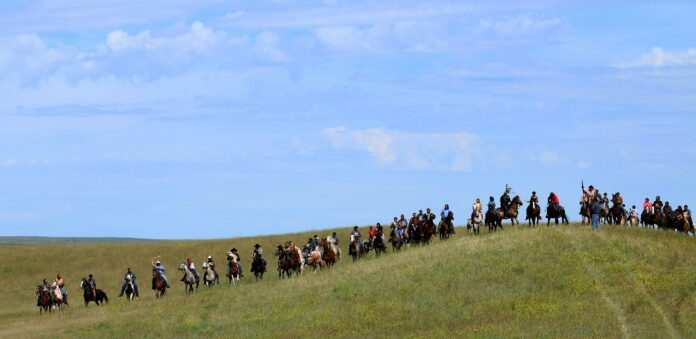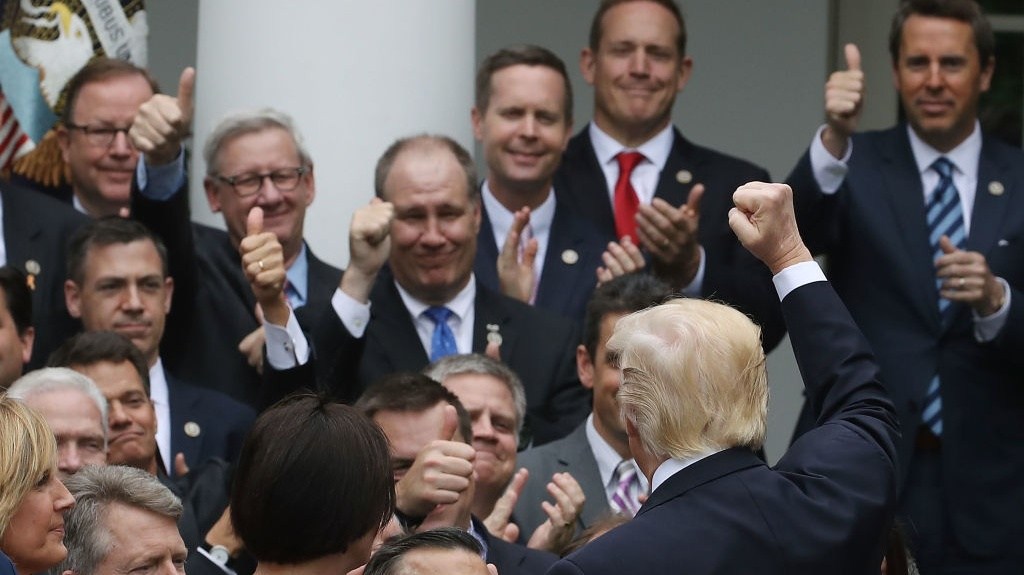By
The Cherokee Constitution of 1827 is printed in two tight columns: English on the left and Cherokee on the right, the intricate letters in neat, even lines. It is the product of the first Cherokee Constitutional Convention that assembled on July 4 of that year in New Echota, Georgia. The document’s introduction mirrors the United States Constitution, but it goes on to declare the tribe independent from the people who had colonized their land.
The constitution is one of many in a new database created by Beth Redbird (Oglala Lakota and Oklahoma Choctaw), a sociologist at Northwestern University, as part of the Tribal Constitutions Project. The effort aims to find, preserve, and catalog the documents written by various tribal governments from 1820 on. The database contains constitutions from more than 350 of the now 574 federally recognized tribes, documents that serve as written records of the many ways tribal governments have asserted independence within a colonial system. They also detail how the tribes address problems inherent in governing bodies, like who has rights, what rights might exist for people who are displaced, and the potential rights of natural places.
One of things missing in our history, Redbird says, “is access to this whole story of what these are, how they came to be, and how they work to structure modern tribes today.” Whether it’s engaging in national policymaking or constitution-making, or asserting tribal rights in courts, Redbird says, “These constitutions can and do matter.”
Redbird started the project four years ago when she asked a researcher to search for tribal constitutions so they could analyze the documents. How many were there, and how many survived? The Native American Rights Fund Indian Law Library had a limited database, and the Library of Congress had a fraction of those passed by federally recognized tribes.
To find more, the team Googled, called up tribal offices, and phoned regional Bureau of Indian Affairs offices. They searched law libraries. They discovered constitutions in appropriations bills from the 1940s and others attached to court cases.
Redbird employed the expertise of Erin Delaney, a law professor at Northwestern University, to help analyze the documents. The pair got a National Science Foundation grant to code the documents—a process that allows someone reading documents to search the text—and they continued looking. Eventually, the team compiled more than 1,000 constitutions into a database that now includes both originals and updated versions.
The database shows how tribes have reacted to U.S. federal policy over time. It tells a different tribal history than the one told by lawmakers of their time or explained in textbooks. It could also give tribal governments more information about how different tribes have governed themselves; how that resulted in different social outcomes, like access to education or housing; and what that might mean for tribal governance in the future.
“It’s the first time that this has been done comprehensively,” says Maggie Blackhawk (Fond du Lac Band Ojibwe), a law professor at New York University and partner of the project through the NYU-Yale Sovereignty Project.
The tribes in what is now the U.S. wrote constitutions under a variety of circumstances and histories. Some tribes have treaties, some have reservations, and some exist in a state where laws have been applied to them, making each document unique and different.
The bulk of the tribal constitutions in the Tribal Constitutions Project database were passed in response to the Indian Reorganization Act of 1934, often called the Indian New Deal. The purpose of the law is contested; according to some accounts, it was an attempt to decrease federal control of Native peoples and increase self-governance. Others saw the Indian Reorganization Act as a continuation of a typical government policy toward Indigenous people.
The Act’s passage marks the first time in decades of federal policy that a tribe could have a legal government in the open. That’s not to say that tribes didn’t have governments between then and the passage of the Dawes Act in 1887, says Redbird. It just means that Native people didn’t share them with U.S. government entities for fear of arrest.
Individual tribes voted on whether to adopt the Indian Reorganization Act. If they did, the Secretary of the Interior approved or denied those constitutions and any subsequent amendments.
The Bureau of Indian Affairs created a template for tribes, which should have opened the door to millions of dollars in loans from the federal government. But the government spent $38 million in the 1920s on Native people, and that number had not budged two decades later. At first, it only took a couple of months for the federal government to approve a constitution, but by the end of the decade, it took an average of two years.
“If you’re a tribe, and you’re hoping to do the kinds of things that the government does, like offer assistance to people who are in need, and manage your own land and your own affairs, then two years is a long time to wait,” Redbird says.
The rate of approved constitutions slowed over time, and the ones that were approved were simpler and more standardized. These documents may not have represented the values and interests of tribes wary of the federal government.
Still, the Indian Reorganization Act, according to Blackhawk, “is the legal framework that continues to structure the government-to-government relationship between the United States and Native nations today.” In short, she says, “It was a very different way of doing colonialism that empowered Native people to form governments and establish a formal relationship with the United States beyond the treaty process.”
Many of the constitutions followed the guidance to include a branch of government called a business council, showing how the Indian Reorganization Act may have been an effort to mold tribes into businesses that cost the federal government less money to administer than tribal states.
There’s some evidence to suggest that the federal government wanted to turn tribes into private corporations that could make a profit and go away, Redbird says. She sums up the government stance like this: “If we can teach them to work, they’ll become white, because the secret to being white is to engage in capitalism. …Like, the biggest problem of Indians is they haven’t learned to be selfish yet,” she says.
In 1953, the federal government passed a resolution approving a measure that allowed states to make tribes illegal, essentially terminating them. At that point tribal constitutional amendments dropped off as tribes kept their policies close to their chests, Redbird says.
Many tribes have since revised their constitutions and continue to do so, particularly those that address current issues like climate change and the rights of non-human relatives, like rivers. This is where the database could prove particularly useful today: providing references, inspiration, and solidarity among tribes to set the course of their own futures.
“There’s lots of pragmatic and hopefully beneficial knowledge to help tribes in their constitutional processes achieve their goals, whatever those goals may be,” Delaney says.
Redbird and her collaborators plan to eventually make the database public and include introductions from the tribes. That way, she says, they could narrate the history of their documents. Though there is inherent risk, considering the tribal and federal government relationship, there is also value, Redbird says.
“Transparency does a lot for you, even if there’s not a direct, immediate, obvious benefit to it,” she says. “The ability to have civil society depends on the ability of people to see the actions of a government, and that means a government both at the tribal level and a state and national level.”
This article originally appeared in Yes! Magazine at https://www.yesmagazine.org/democracy/2024/06/17/history-database-tribe-constitution.
Yes! Magazine is a nonprofit, independent media organization dedicated to telling stories of … . Learn more at Yes! Magazine



































